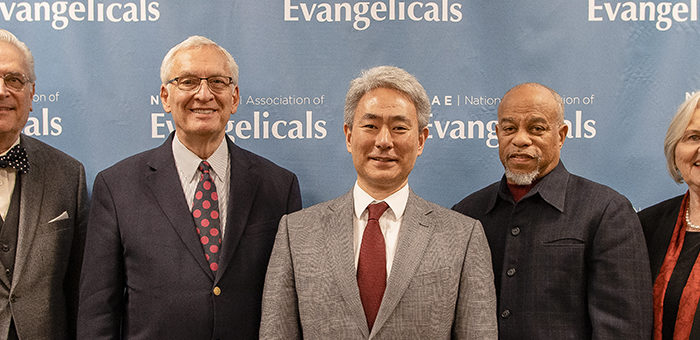Jeff Lilley, at age 58, completed eight years of service as Seattle Union Gospel Mission’s president in 2018. Having previously been executive director of one of the nation’s largest camp and conference centers, Lilley felt called back to his home in Southern California to serve as church staff and be closer to his grandchildren.
Months later, after a nationwide search, Scott Chin was named as president of the Mission. Chin had followed a common pathway for ministry CEOs: work in the corporate world, shift to a Christ-centered nonprofit, invitation to senior staff at the Mission, and then acceptance of a call to its presidency — in his case, at age 48. Founded in 1932, the Mission loves and cares for the homeless throughout greater Seattle. Now a $24 million organization, the Mission addresses root causes and breaks the cycle of homelessness by meeting urgent physical needs, building relationships, and offering long-term recovery programs.
More recently, Bob Merritt, after serving as senior pastor for 28 years at Eagle Brook Church in greater Minneapolis, where attendance grew from 300 to more than 20,000 during his tenure, announced his intent to retire in 2020 at age 63.
“I want to hand off the baton when I’m running at full speed so that the whole team wins,” he said as part of his public announcement to the congregation. Indeed, the church is in the best position ever, both financially and numerically. More than 6,000 people began to follow Christ during 2018, and in 2019 Eagle Brook opened its eighth and ninth campuses.
Merritt’s announcement included identifying his successor, Jason Strand, age 40, a long-time teaching pastor at the church. “This past year the board took Jason through a long process of assessing his abilities and readiness … and comparing him to other candidates,” Merritt explained to the congregation. Strand then emerged as the board’s unanimous recommendation, which the congregation voted to affirm. “It’s necessary and good for every organization to transition to younger leadership who has a new set of eyes and the energy to keep charging the hill,” Merritt concluded.
What makes these stories newsworthy? In today’s celebrity era, it’s easy to assume that unique and strategic positions like these cannot find a viable successor. Not true. Also today as Baby Boomers move on from ministries they’ve founded or significantly grown, the common stereotype is that new generations lack interest in continuing an organization that operates on such a large scale. Not true either.
In fact, the opposite is often the case. While news media tend to highlight succession disasters (it’s rare to find a headline titled “Smooth, Seamless Succession Here”), the good news is that healthy succession planning is on the rise. Looking back over the last decade or so, the science of succession is being honed among evangelical churches and ministries. Today’s successions tend to involve:
1. More Proactive Planning
The number of boards with a written succession plan is inching upward. Succession conversations are becoming more normal with less stigma and less secrecy. More people are realizing, “Succession planning is an ongoing process, not a single event,” in the words of the book “Next: Pastoral Succession that Works” by William Vanderbloemen and Warren Bird.
When William Vanderbloemen and I wrote the first edition of our book, our hope was that this conversation would become no longer taboo. At the time the main market seemed to be pastors and parachurch leaders over 70 who didn’t know how to manage their succession. Now there are entire conferences dedicated to helping all senior staff develop a leadership pipeline, including succession. Now pastors in their 50s are hiring consultants to figure out a 10-year succession plan.
Boards likewise are putting more emphasis on the issue. “Boards have a better understanding that there is a substantial difference between transition of the top leader and succession planning,” says Dan Busby, president of Evangelical Council for Financial Accountability. “Top leader transition is an intermittent event that is timeline-driven. Succession planning, on the other hand, reflects an ongoing, continuous process that boards, with the help of their chief executive, implement to: create the conditions for the incumbent leader to succeed, understand the organization’s current and future strategy, and ensure that a sound infrastructure is in place whenever the search for the next top leader is launched.”
2. More Players
When a CEO or pastor transitions, it affects spouse, family, staff, board and key donors. When the leader changes, shifts in role for many of these other players seem inevitable. As a result, the concept of succession now tends to include far more than one person. The question of “what does a successful succession look like?” tends today to receive analysis on many levels. They include what success looks like for the leader, for the leader’s family, for the board, for the ministry staff, for the ministry itself, and for the community the ministry is seeking to serve.
3. More Rigorous Vetting of Internal Candidates
Leaders have long understood that when you need to change the culture, you hire from without, but when you want to reinforce the existing culture, you hire from within. Since internal candidates are less disruptive, more value is typically placed on cultivating and selecting a known and trusted person from within the organization, or at least someone with a strong previous relationship to the organization.
Internal candidates may still be preferred, but today a new hoop has emerged for them. The attitude now is that if you have a really good internal candidate, the best thing you can do is conduct a full search, comparing that candidate to others, both internally and externally.
4. More Collaboration
Decision makers are increasingly asking for the outgoing leader’s advice and help. This involves everyone from board chairs to bishops. Even when the leader has no official voice in the process, their boards or other ministry supervisors seek their input and guidance. In fact, as succession planning is increasingly seen as a necessary part of leadership development, leaders are increasingly putting energy into strengthening their talent pool, and doing so as a corporate value, inviting input and participation at every level.
5. More Financial Savvy
Churches and ministries are realizing that their single greatest potential cost in the transition process is recovering from a botched succession. A poor succession can create the proverbial leak in the dam that leads to a loss of momentum, indecision about target audience, a blurring of ministry vision, and disengagement by key volunteers and donors. Like paying for insurance, succession planners often go the extra mile today to vet, onboard, and regularly review the new leader.
Likewise surveys of those who lead Christ-centered ministries affirm that personal finance is often the dominant reason they stay in place far longer than ministry outcomes warrant. Often they lack the financial resources to handle a transition, so they find reasons to hold onto their present position. Smart boards plan early in their leader’s tenure to make sure that they address points of potential financial insecurity in their leader.
6. More Senior Ages
In considering their decision to retire, people today monitor their health and energy more than their age. As a result, retirement successions are occurring at older ages, consistent with the aging of the nation’s overall population. For those retiring “older,” 70 is the new 60. Sadly, for those with financial challenges — which is the most commonly cited reason for not retiring — the final years too often are ones of organizational decline. For them, waiting longer doesn’t serve the church or ministry well.
While some are staying longer due to improved and longer life spans, others are leaving earlier for the same reason: They started young, they led well, and now they want to start a new chapter in a different ministry where they sense God’s calling.
7. More Consultants
There is a pronounced rise in the number of search firms that work with faith-based groups. Hiring a successor involves an anxiety-ridden fear of the unknown, even when there’s a strong internal candidate. The use of outside organizations or coaches is becoming more common and normal.
Always Remember: You Are an Interim Leader
As William Vanderbloemen and I advise in “Next”: “Sooner or later, unless Jesus returns during your lifetime, there will be a leadership baton pass.” Translation: Everyone — in every role — is interim. Someone is certain to follow you. “Thinking about that transition ahead of time might make all the difference in your church’s or ministry’s legacy,” we conclude.
This article originally appeared in Evangelicals magazine.
Warren Bird is vice president of research and equipping at the Evangelical Council for Financial Accountability. Warren has led in various pastoral positions, taught at several seminaries, and served most recently for 13 years at Leadership Network as director of research and intellectual capital. He has also co-authored 30 books for church leaders on topics like breaking growth barriers, healthy mergers and pastoral succession. He holds an M.A. from Wheaton College, an M.Div. from Alliance Theological Seminary, and a Ph.D. from Fordham University.




 View All Articles
View All Articles 





























